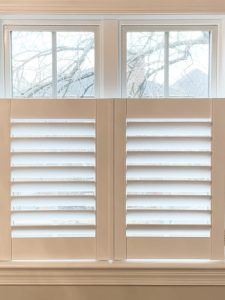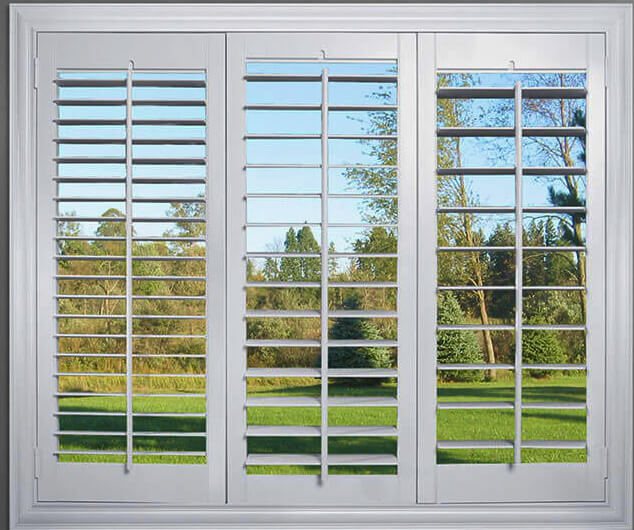Shutters
Offering both high-end curb appeal and interior comfort, interior shutters offer immediate return on investment.
Shutters are the only window treatment that can be included in a mortgage!
With our onsite consultation, we bring the store to you.
Interior Shutters (also known as Plantation Shutters) are a functional window treatment that literally span centuries.
Originally manufactured in various woods, the industry has grown immensely over the last decade in quality, use of green products, and production.
Due to the method of installation, interior shutters are the only window treatment that is considered “a permanent part of the home” and can therefore be included in a mortgage!
Read on in this article to learn professional shutter selection tips from Valley Shades and Shutters.
Wood or composite shutters?
Wood: There are various woods used by different manufacturers. Make sure that wherever you source your shutters from, the manufacturing process takes into consideration the temperatures, sun exposure, and humidity of your area. These factors can negatively impact the paints, stains, and clearcoats of wooden shutters and cause them to fail prematurely.
Composite: Be careful with this term when choosing a faux-wood shutter. Some companies use mostly (if not solid) vinyl. These sometimes look very shiny or what we call “plastic-y”.
Think of “composite” in terms of meaning “not-wood.” This is not a negative trait but can impact the way the finished product looks.
Some composite shutters are even waterproof, which is great if the window is in a pool house, on a sunporch, or inside a shower or steam room.
Other composite shutters are a combination of various materials that are specifically designed for the environment where you live! These are a less expensive shutter and usually have some longevity advantages over a solid wood product.
image of outside shutters
Shutters are a great investment that offers immediate return on a home’s value while at the same time providing a beautiful aesthetic to the front of any home.
We have gained a wealth of knowledge about many top manufactures and thousands of products over our 30+ years of doing business. We are happy to use our connections to help you choose shutters from manufacturers with the best warrantees.

What is a Louver? Louvers refer to the individual slats or blades that rotate open and closed to control privacy and light-entry with your window shutters. They are typically made of materials such as wood, metal, or plastic and can be positioned horizontally or vertically.
Interior Shutter Options
Option 1 – Louver Size: While there are more than half a dozen louver sizes available in the industry, the 2-½” traditional and 3 or 3-½” add more view-through and are a better scale for larger windows. The large 4-½” louvers are best suited for large glass areas of coastal homes and sliding glass doors.

| Option 2a – Invisible tilt: this option uses a geared mechanism in the side channels of the shutter panel. Longevity is not compromised using this option. This option provides a clean modern look to the shutter panels. |
|
| Option 2b – Rear tilt: this option mounts the “tilt bar” on the rear of the louvers closer to the window and also offers a clean modern appearance. | |
| Option 2c – Standard center tilt bar: this option is the “traditional” shutter louver operation. A vertical bar is stapled to each louver and keeps them in alignment. This bar is NOT a handle! Operation of all louvers is by grasping one of the louvers to tilt the attached set. | |
| Option 2d – Offset tilt bar: this option moves the visible, stapled tilt bar to the hinge side of the panel, but operates the louvers exactly as the center tilt bar does. This bar is NOT a handle! |
Option 3 – Split Tilt: This option allows the top and bottom sections of louvers to move independently while eliminating the need for horizontal structural pieces that would break up the clean lines of the shutter panels. When louvers are aligned or fully closed – it gives the appearance that all the louvers are connected. Not only does it allow for clean lines, but also offers extra privacy when the bottom section of louvers are closed.
Option 4 – Divider rail: This is a solid piece of material usually centered horizontally halfway in each shutter panel. This allows the top louvers and bottom louvers to move independently for better privacy
and light control. The divider rail is needed for structural rigidity depending on the height of the shutter panel, and the locations can also be customized for the best aesthetic.
Option 5 – Mounting:
- Option 5a – Direct to trim: One of the largest myths for interior shutters is that inside mounting shutters will void the use of your tilt-in windows. NOT TRUE!! There are, however, some limitations. The window must have wood (or MDF) casements and trim, and the opening needs to be within ¼” of being square. Due to the custom adjustments needed on a direct mount installation, many companies just do not have the qualified professional installers to confidently offer this option.
- Option 5b – Framed: There are multiple sizes and profiles of frames that can be used to mount shutters to any window or door opening. These are great for drywall wrapped windows and give a high-end finished product of making your trim and shutter panels appear “perfectly” square.
Option 6 – Panel layout: Panels as wide as 42” are available in some product lines. Large panels allow a better view and use of the most glass and light. The panel layout is completely customizable depending on your opening. Sliding panels on tracks and bi-fold configurations can also make shutters very functional. Use of T-posts allows the shutters to blend in with any architectural elements of the window. Panels are all hinged, and magnets are used for easy access to clean or maintain the window glass.
Option 7 – Specialty shapes: Shutters are usually rectangles and square corners. But circles, ovals, arches, and trapezoids can also be sources. With virtually any opening you can find, there is a shutter option that is available.
Option 8 – Motorization: YES!! Motorized louvers in shutters are available. Even ones that can be set on a timer or operated remotely through your home wi-fi.